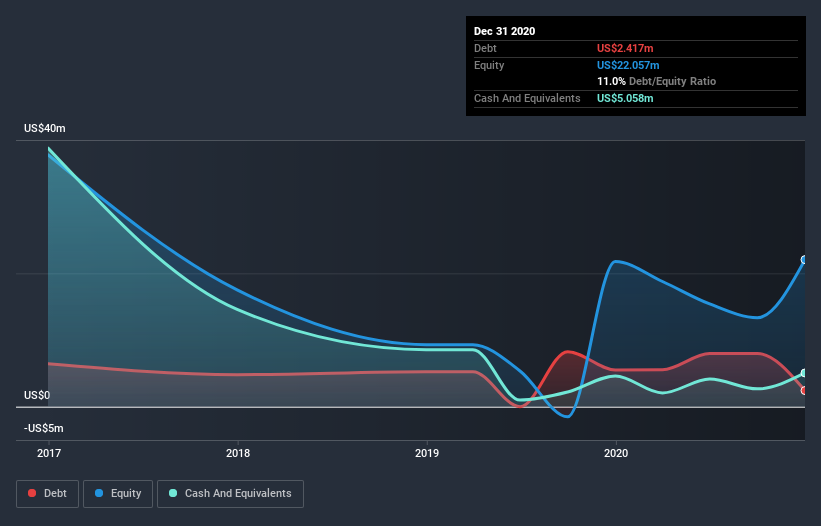The external fund manager backed by Berkshire Hathaway's Charlie Munger, Li Lu, makes no bones about it when he says 'The biggest investment risk is not the volatility of prices, but whether you will suffer a permanent loss of capital.' When we think about how risky a company is, we always like to look at its use of debt, since debt overload can lead to ruin. We note that Oblong Inc. (NASDAQ:OBLG) does have debt on its balance sheet. But the more important question is: how much risk is that debt creating?
Why Does Debt Bring Risk?
Generally speaking, debt only becomes a real problem when a company can't easily pay it off, either by raising capital or with its own cash flow. Ultimately, if the company can't fulfill its legal obligations to repay debt, shareholders could walk away with nothing. However, a more usual (but still expensive) situation is where a company must dilute shareholders at a cheap share price simply to get debt under control. By replacing dilution, though, debt can be an extremely good tool for businesses that need capital to invest in growth at high rates of return. When we think about a company's use of debt, we first look at cash and debt together.
Check out our latest analysis for Oblong
What Is Oblong's Net Debt?
You can click the graphic below for the historical numbers, but it shows that Oblong had US$2.42m of debt in December 2020, down from US$5.51m, one year before. But it also has US$5.06m in cash to offset that, meaning it has US$2.64m net cash.

A Look At Oblong's Liabilities
We can see from the most recent balance sheet that Oblong had liabilities of US$5.58m falling due within a year, and liabilities of US$1.51m due beyond that. Offsetting this, it had US$5.06m in cash and US$3.17m in receivables that were due within 12 months. So it actually has US$1.14m more liquid assets than total liabilities.
Having regard to Oblong's size, it seems that its liquid assets are well balanced with its total liabilities. So while it's hard to imagine that the US$138.1m company is struggling for cash, we still think it's worth monitoring its balance sheet. Succinctly put, Oblong boasts net cash, so it's fair to say it does not have a heavy debt load! When analysing debt levels, the balance sheet is the obvious place to start. But ultimately the future profitability of the business will decide if Oblong can strengthen its balance sheet over time. So if you want to see what the professionals think, you might find this free report on analyst profit forecasts to be interesting.
Over 12 months, Oblong reported revenue of US$15m, which is a gain of 19%, although it did not report any earnings before interest and tax. We usually like to see faster growth from unprofitable companies, but each to their own.
So How Risky Is Oblong?
By their very nature companies that are losing money are more risky than those with a long history of profitability. And the fact is that over the last twelve months Oblong lost money at the earnings before interest and tax (EBIT) line. Indeed, in that time it burnt through US$6.6m of cash and made a loss of US$8.2m. But at least it has US$2.64m on the balance sheet to spend on growth, near-term. Even though its balance sheet seems sufficiently liquid, debt always makes us a little nervous if a company doesn't produce free cash flow regularly. When analysing debt levels, the balance sheet is the obvious place to start. But ultimately, every company can contain risks that exist outside of the balance sheet. Case in point: We've spotted 3 warning signs for Oblong you should be aware of, and 2 of them are concerning.
If you're interested in investing in businesses that can grow profits without the burden of debt, then check out this free list of growing businesses that have net cash on the balance sheet.
If you decide to trade Oblong, use the lowest-cost* platform that is rated #1 Overall by Barron’s, Interactive Brokers. Trade stocks, options, futures, forex, bonds and funds on 135 markets, all from a single integrated account. Promoted
New: AI Stock Screener & Alerts
Our new AI Stock Screener scans the market every day to uncover opportunities.
• Dividend Powerhouses (3%+ Yield)
• Undervalued Small Caps with Insider Buying
• High growth Tech and AI Companies
Or build your own from over 50 metrics.
This article by Simply Wall St is general in nature. It does not constitute a recommendation to buy or sell any stock, and does not take account of your objectives, or your financial situation. We aim to bring you long-term focused analysis driven by fundamental data. Note that our analysis may not factor in the latest price-sensitive company announcements or qualitative material. Simply Wall St has no position in any stocks mentioned.
*Interactive Brokers Rated Lowest Cost Broker by StockBrokers.com Annual Online Review 2020
Have feedback on this article? Concerned about the content? Get in touch with us directly. Alternatively, email editorial-team (at) simplywallst.com.
About NasdaqCM:OBLG
Oblong
Provides multi-stream collaboration products and managed services for network solutions and video collaboration in the United States and internationally.
Excellent balance sheet with moderate risk.
Similar Companies
Market Insights
Community Narratives



